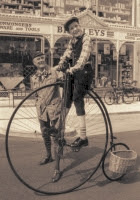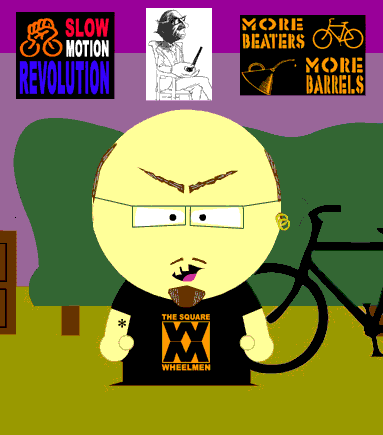Bike mechanics
and what they've done
 Over the last 150 years, many of the major technological advances in the United States and even the world have come from an almost forgotten group of innovators. If you have ever driven a car, flown on a plane or, as a woman, been thankful you don't have to wear corsets and large frumpy dresses - you owe gratitude to the bike and the mechanics who built them.
Over the last 150 years, many of the major technological advances in the United States and even the world have come from an almost forgotten group of innovators. If you have ever driven a car, flown on a plane or, as a woman, been thankful you don't have to wear corsets and large frumpy dresses - you owe gratitude to the bike and the mechanics who built them. The person who invented the bicycle or the specific date on which this occurred is still debated, but during the mid-1800s, wealthy folks began rolling around on heavy, single-speed bikes. Few could afford them because early bicycles cost around $300, a year's wages at the time.
The person who invented the bicycle or the specific date on which this occurred is still debated, but during the mid-1800s, wealthy folks began rolling around on heavy, single-speed bikes. Few could afford them because early bicycles cost around $300, a year's wages at the time. As costs came down bike shops sprang up all over the nation. Everyone jumped on the bike bandwagon. By 1890, bikes were a full-blown craze. Henry Ford couldn't build enough to keep up with demand. Some towns banned them, declaring that they startled horses and ... get this ... caused too much traffic congestion.
As costs came down bike shops sprang up all over the nation. Everyone jumped on the bike bandwagon. By 1890, bikes were a full-blown craze. Henry Ford couldn't build enough to keep up with demand. Some towns banned them, declaring that they startled horses and ... get this ... caused too much traffic congestion. At the same time, the car had crossed the Atlantic to the US. The first American-made cars arrived in 1896. Who built them? Bike mechanics Frank and Charles Duryea. As with all things new, Americans first considered cars a stupid fad that would never replace a sturdy horse or a steel frame bike. So during their first 20 years, cars were virtually ignored as most mechanics concentrated on technological advances for bikes.
At the same time, the car had crossed the Atlantic to the US. The first American-made cars arrived in 1896. Who built them? Bike mechanics Frank and Charles Duryea. As with all things new, Americans first considered cars a stupid fad that would never replace a sturdy horse or a steel frame bike. So during their first 20 years, cars were virtually ignored as most mechanics concentrated on technological advances for bikes. In 1903, Horatio Nelson Jackson wagered $50 that he could drive his car across the United States in fewer than 90 days. He did it in 63. He hired Sewall Crocker, a skilled bike mechanic, to help drive and make repairs. Jackson could never have made the trip across the continent without Crocker. The trip established the durability and speed of the automobile, and the car industry began. Ford joined the auto magnates and introduced the assembly line to mass-produced affordable cars for the entire nation.
In 1903, Horatio Nelson Jackson wagered $50 that he could drive his car across the United States in fewer than 90 days. He did it in 63. He hired Sewall Crocker, a skilled bike mechanic, to help drive and make repairs. Jackson could never have made the trip across the continent without Crocker. The trip established the durability and speed of the automobile, and the car industry began. Ford joined the auto magnates and introduced the assembly line to mass-produced affordable cars for the entire nation. On Dec. 17, 1903, two men from Ohio, both bike mechanics, were taking flight in their homemade airplane. The Wright brothers didn't invent the idea of an airplane or the concept of a wing and lift. The brothers used current technology to build a balanced flying machine that could get off the ground. You know the rest of the story, I'm sure.
On Dec. 17, 1903, two men from Ohio, both bike mechanics, were taking flight in their homemade airplane. The Wright brothers didn't invent the idea of an airplane or the concept of a wing and lift. The brothers used current technology to build a balanced flying machine that could get off the ground. You know the rest of the story, I'm sure. The women's fashion industry owes many thanks to the bikes. Getting dressed in the 1800s was a full-time job. However, extravagant dresses and bike chains didn't mix. Soon women were flying over handlebars and taking nose dives in the streets. Men announced that women were too fragile for cycling. When their fragility was called into question, women respond. They ditched dresses for bloomers and rolled like mad. Men and proper women immediately called them loose for their improper dress.
The women's fashion industry owes many thanks to the bikes. Getting dressed in the 1800s was a full-time job. However, extravagant dresses and bike chains didn't mix. Soon women were flying over handlebars and taking nose dives in the streets. Men announced that women were too fragile for cycling. When their fragility was called into question, women respond. They ditched dresses for bloomers and rolled like mad. Men and proper women immediately called them loose for their improper dress. Susan B. Anthony once stated that the bicycle has done more to emancipate women than anything else in the world. A cycling supporter agreed, writing to the Northern Wheeler in 1893: I am tolerably certain that the net result [of the bike] will be that woman will take her true position as man's equal. How did a simple two-wheeled machine accomplish all this? Women, in general, couldn't drive. The bike gave women mobility and freedom. Also, the pool of eligible men skyrocketed when a woman could pedal to the surrounding towns.
Susan B. Anthony once stated that the bicycle has done more to emancipate women than anything else in the world. A cycling supporter agreed, writing to the Northern Wheeler in 1893: I am tolerably certain that the net result [of the bike] will be that woman will take her true position as man's equal. How did a simple two-wheeled machine accomplish all this? Women, in general, couldn't drive. The bike gave women mobility and freedom. Also, the pool of eligible men skyrocketed when a woman could pedal to the surrounding towns. For millennia, mankind never advanced past Mr. Ed until bike mechanics developed the car and the airplane. Fewer than 100 years after the bike boom, Americans were standing on the moon.
For millennia, mankind never advanced past Mr. Ed until bike mechanics developed the car and the airplane. Fewer than 100 years after the bike boom, Americans were standing on the moon.Labels: history, pensées, that which rolls, writing








0 Comments:
Post a Comment
<< Home